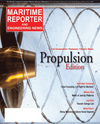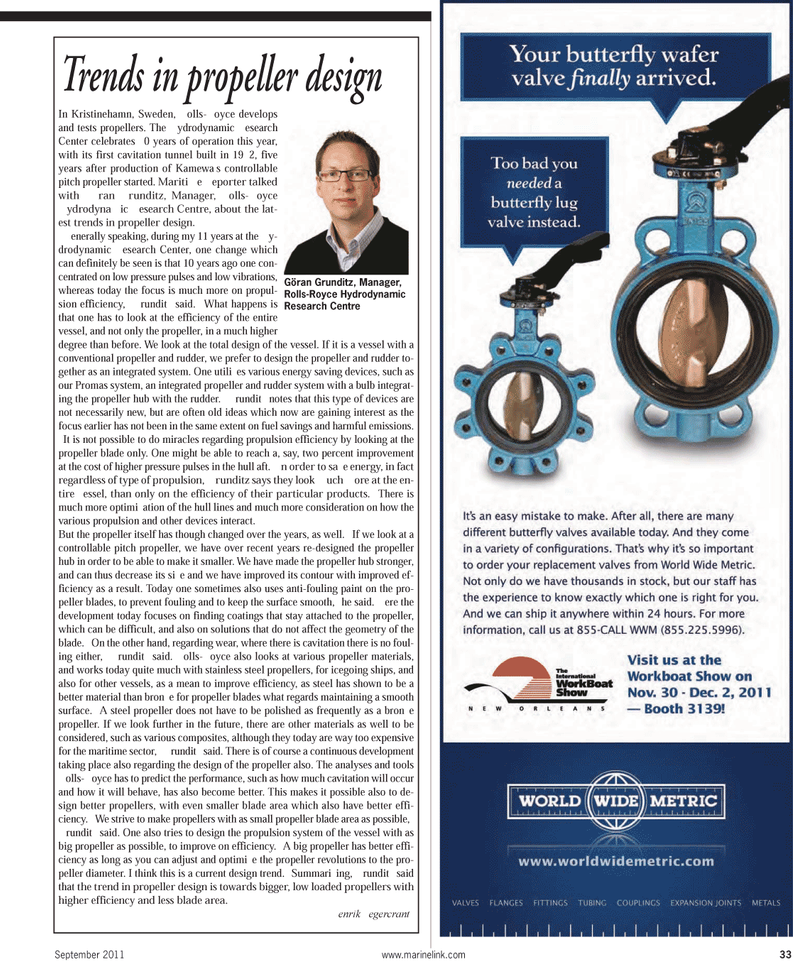
Page 33: of Maritime Reporter Magazine (September 2011)
Marine Propulsion Annual
Read this page in Pdf, Flash or Html5 edition of September 2011 Maritime Reporter Magazine
September 2011www.marinelink.com 33Trends in propeller design In Kristinehamn, Sweden, olls-oyce develops and tests propellers. The ydrodynamic esearch Center celebrates 0 years of operation this year, with its first cavitation tunnel built in 192, five years after production of Kamewas controllable pitch propeller started. Maritie eporter talked with ran runditz, Manager, olls-oyce ydrodynaic esearch Centre, about the lat- est trends in propeller design. enerally speaking, during my 11 years at the y- drodynamic esearch Center, one change which can definitely be seen is that 10 years ago one con- centrated on low pressure pulses and low vibrations, whereas today the focus is much more on propul-sion efficiency, rundit said. What happens is that one has to look at the efficiency of the entire vessel, and not only the propeller, in a much higher degree than before. We look at the total design of the vessel. If it is a vessel with a conventional propeller and rudder, we prefer to design the propeller and rudder to- gether as an integrated system. One utilies various energy saving devices, such as our Promas system, an integrated propeller and rudder system with a bulb integrat- ing the propeller hub with the rudder. rundit notes that this type of devices are not necessarily new, but are often old ideas which now are gaining interest as the focus earlier has not been in the same extent on fuel savings and harmful emissions. It is not possible to do miracles regarding propulsion efficiency by looking at the propeller blade only. One might be able to reach a, say, two percent improvement at the cost of higher pressure pulses in the hull aft. n order to sae energy, in fact regardless of type of propulsion, runditz says they look uch ore at the en- tire essel, than only on the efficiency of their particular products. There ismuch more optimiation of the hull lines and much more consideration on how the various propulsion and other devices interact. But the propeller itself has though changed over the years, as well. If we look at a controllable pitch propeller, we have over recent years re-designed the propeller hub in order to be able to make it smaller. We have made the propeller hub stronger, and can thus decrease its sie and we have improved its contour with improved ef- ficiency as a result. Today one sometimes also uses anti-fouling paint on the pro- peller blades, to prevent fouling and to keep the surface smooth, he said. ere the development today focuses on finding coatings that stay attached to the propeller, which can be difficult, and also on solutions that do not affect the geometry of the blade. On the other hand, regarding wear, where there is cavitation there is no foul- ing either, rundit said. olls-oyce also looks at various propeller materials, and works today quite much with stainless steel propellers, for icegoing ships, and also for other vessels, as a mean to improve efficiency, as steel has shown to be a better material than brone for propeller blades what regards maintaining a smooth surface. A steel propeller does not have to be polished as frequently as a brone propeller. If we look further in the future, there are other materials as well to be considered, such as various composites, although they today are way too expensive for the maritime sector, rundit said. There is of course a continuous development taking place also regarding the design of the propeller also. The analyses and tools olls-oyce has to predict the performance, such as how much cavitation will occur and how it will behave, has also become better. This makes it possible also to de- sign better propellers, with even smaller blade area which also have better effi- ciency. We strive to make propellers with as small propeller blade area as possible, rundit said. One also tries to design the propulsion system of the vessel with as big propeller as possible, to improve on efficiency. A big propeller has better effi- ciency as long as you can adjust and optimie the propeller revolutions to the pro- peller diameter. I think this is a current design trend. Summariing, rundit said thatthe trend in propeller design is towards bigger, low loaded propellers with higher efficiency and less blade area. enrik egercrant Göran Grunditz, Manager, Rolls-Royce Hydrodynamic Research Centre

 32
32

 34
34
